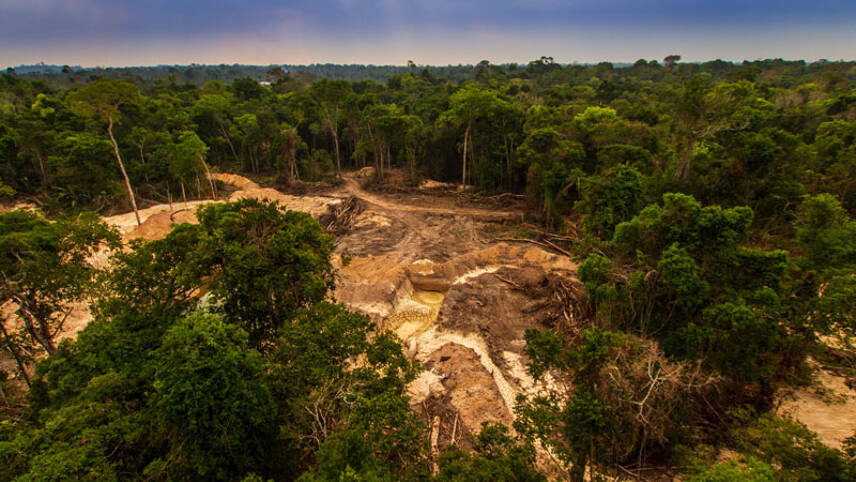Register for free and continue reading
Join our growing army of changemakers and get unlimited access to our premium content

Pictured: Deforestation in the Amazon caused by an illegal mining operation
After two years of design and development, the 14 recommended disclosures and a suite of additional implementation guidance have been unveiled.
It is hoped that first-mover companies will begin stating their intentions to begin reporting in line with the framework within the next few days and weeks. Several businesses, including Natura&Co, Holcim and Reckitt, have already been trialling TNFD adoption in private using a string of beta versions.
One business – GSK – has already stated its intention to produce its first TNFD-aligned report in 2026, using 2025 data.
A further influx of corporate support is expected at the next annual World Economic Forum Meeting in Davos. This is tabled for January 2024.
By disclosing in line with the TNFD, businesses will be providing information in a unified format to stakeholders including regulators and investors. They will also be preparing for a forthcoming mandate on corporate nature-related disclosures, which more than 190 nations are committed to implementing by 2030 under the UN’s biodiversity treaty.
TNFD co-chair Elizabeth Mrema said that there is a growing recognition that “nature risk is financial risk”, after decades of businesses externalizing their nature-related dependencies and impacts.
Mrema said: “Scaling up action to restore the resilience of nature is now a global policy and regulatory priority, and it is business-critical, posing significant long-term financial impact if not acted upon. Increasingly extreme weather events, the collapse of ecosystems and the extinction of species presents physical risks to business. Policymaking and regulatory attention stemming from growing community concern about nature loss also create elevated transition risks.
“Business-as-usual is no longer an option and business and finance can no longer consider nature and biodiversity as just a Corporate Social Responsibility (CSR) issue. It is now squarely a central and strategic risk management issue.”
What is included?
NGOs, think tanks and sustainability reporting platforms supporting the TNFD have called the framework “science-based” and stated that it should facilitate “holistic decision-making” by business leaders.
A total of 14 reporting recommendations have been launched, including recommendations to disclose nature-related impacts, risks and dependencies across the value chain. As is the case with the Taskforce on Climate-Related Financial Disclosures’ (TCFD) framework, the recommendations include assessing risk in a range of future scenarios.
The 14 TNFD recommendations are grouped into the same four pillars as the TCFD. These are governance, strategy, risk and impact management, and metrics and targets.
Businesses will not simply be encouraged to measure their impacts. The framework should compel them to set science-based targets and properly embed nature-related considerations in their strategies. The Science-Based Targets Network’s standards for businesses were notably launched in May.
The TNFD launched four beta versions of the framework before today’s (18 September) announcement. From the most recent beta version, the framework retains its definitions of upstream, downstream, operational and financed impacts.
The framework also draws on other relevant standards including the International Sustainability Standards Board (ISSB) and the Global Reporting Initiative (GRI), both of which were knowledge partners to the TNFD.
CDP alignment
CDP has already stated its intention to align its disclosure platform set-up with the TNFD. It is aiming to reflect the framework in its system from 2024.
CDP provides a platform for businesses to disclose their impacts relating to deforestation, biodiversity, water scarcity and plastic pollution. Around 4,000 disclosed last year on water security and some 1,000 disclosed on forests. A further 7,700 responded to CDP’s biodiversity-related questions.
“Many questions” in existing CDP questionnaires align with TNFD framework metrics, CDP’s chief impact officer Nicolette Bartlett said. She added that the framework also covers “key areas” which CDP will expand to cover in the coming years, such as oceans.
“With more than 18,700 companies, worth half of global market capitalization, disclosing through CDP in 2022 alone, this alignment will be critical in implementing the TNFD framework across the global economy, increasing harmonisation, enabling access to standardised data, reducing the reporting burden on companies and paving the way for robust regulation on nature-related disclosure,” Bartlett said.


Please login or Register to leave a comment.